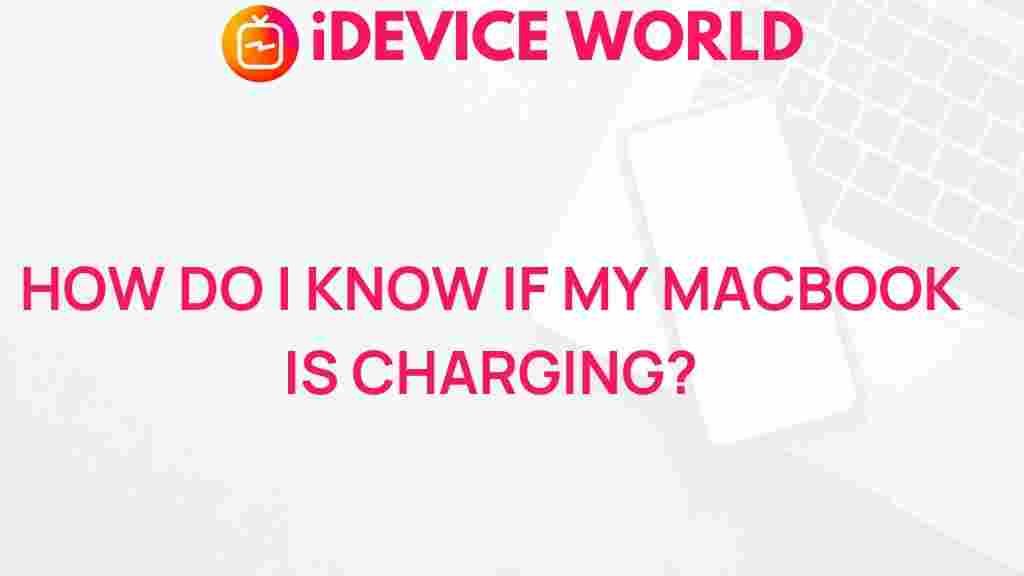Uncovering the Mystery: Signs Your MacBook is Charging
As a proud owner of a MacBook, you may sometimes wonder if your device is charging properly. Understanding the signs that indicate your MacBook is charging can help you avoid running out of battery at inconvenient times. In this article, we will explore various indicators that confirm your MacBook is indeed charging and provide troubleshooting tips for any issues you might encounter.
Understanding Your MacBook’s Charging Mechanism
Your MacBook uses a sophisticated charging system designed to optimize battery health and performance. The process starts when you connect your MacBook to a power source using the appropriate charger. Here’s how to recognize when your MacBook is charging:
- Charger Connection: When you plug in the charger, the connector should securely attach to the charging port without any resistance.
- Indicator Light: If you have a MagSafe charger, check the LED indicator; it will glow amber when charging and green when fully charged.
- System Preferences: You can also monitor charging status through the battery icon in the menu bar.
Visual Indicators on Your MacBook
Recognizing visual cues can significantly help in understanding whether your MacBook is charging. Here are some signs to look for:
- Battery Icon: The battery icon on the menu bar changes to a lightning bolt symbol, indicating that your MacBook is charging.
- Screen Brightness: If your screen brightness increases when connected to power, it is a sign that your MacBook is charging.
- System Alerts: Upon connecting the charger, you may receive a notification confirming the connection.
Checking Battery Status in macOS
To check the battery status, follow these steps:
- Click on the battery icon in the upper right corner of your screen.
- Look for the option that indicates whether your MacBook is charging.
- For more detailed information, select “System Preferences” and navigate to “Battery.”
In this section, you can view the charging status and see additional settings to optimize battery life.
Common Issues That Affect Charging
Even with clear signs that your MacBook is charging, you may occasionally face issues. Here are some common problems and their solutions:
- Faulty Charger: Ensure that the charger is functioning properly. Try using a different charger to rule out any issues.
- Dirty Ports: Check for dust or debris in the charging port. A clean port ensures a better connection.
- Software Glitches: Restart your MacBook to clear temporary software issues that might affect charging.
Troubleshooting Charging Issues
If your MacBook is not charging as expected, here are some troubleshooting steps you can follow:
- Unplug the charger and inspect both the charger and the charging port for any visible damage.
- Reconnect the charger securely and check for any changes in the battery icon.
- Reset the System Management Controller (SMC), which can help resolve power-related issues. To do this:
- Shut down your MacBook.
- Press and hold the Shift, Control, Option, and Power buttons for 10 seconds.
- Release all keys and turn on your MacBook.
If you continue to experience issues, consider visiting an Apple support page for further assistance.
External Factors Affecting Charging
Several external factors can influence the charging process of your MacBook:
- Temperature: Extreme temperatures can affect battery performance. Ensure that your MacBook is in a suitable environment.
- Electrical Source: Make sure the outlet is functioning properly. Try connecting to a different outlet to see if the issue persists.
- Adapters: Using an incompatible or third-party adapter can lead to charging problems. Always use Apple-certified accessories.
Maintaining Your MacBook’s Battery Health
To ensure your MacBook’s battery remains healthy and charges efficiently, consider the following tips:
- Regular Software Updates: Keeping your macOS updated helps improve battery management.
- Avoid Overcharging: Disconnect the charger once the battery reaches 100% to prevent long-term damage.
- Battery Calibration: Occasionally let your MacBook run on battery until it dies, then fully charge it again to calibrate the battery.
Conclusion
Understanding the signs that your MacBook is charging is crucial for maintaining its battery health and ensuring optimal performance. By recognizing the visual indicators, checking the battery status, and troubleshooting common issues, you can enhance your MacBook experience. Remember to keep your software updated and follow best practices for battery maintenance to ensure a long-lasting device.
For more tips on MacBook maintenance, feel free to check our guide on optimizing MacBook performance.
This article is in the category Guides & Tutorials and created by iDeciveWorld Team
